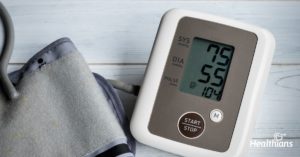Contributed by -Healthians Team
While most of us are quite conscious about blood pressure not shooting up too high, its drop to low levels can also become a problem. The symptoms it causes and the risks it poses may stop you from living your life to the fullest. Commonly, natural remedies can help increase blood pressure if you are suffering from too low levels. But sometimes, professional help might be needed. Knowing what is low blood pressure and when exactly it becomes a problem for you can help you understand what your next steps should be to manage it and avoid any complications.
Low blood pressure
Blood pressure is the force of blood against the walls of the blood vessels. Its measurements consist of two numbers – systolic pressure and diastolic pressure.
The top number is the systolic pressure. It represents the pressure while the heart is beating. And the bottom number is the diastolic pressure. It’s the pressure while the heart rests between beats.
Blood pressure is measured in millimetres of mercury (mmHg). Typically, 120/80 mmHg is considered normal blood pressure range. Though, it can fluctuate even in healthy individuals.
Blood pressure is considered too low if the readings are below 90/60 mmHg. Medically, it is called hypotension.
Now, having low blood pressure is normal unless it starts causing symptoms. Some health conditions can be the causing factor and treating them can give you relief.

Low blood pressure symptoms
Some people may not have any low blood pressure symptoms and that’s absolutely normal. It’s normally seen in youngsters and athletes. However, in others, the following symptoms can be noticed –
- Blurred vision
- Confusion
- Dizziness
- Fainting
- Fatigue
- Chills
- Feeling thirsty
- Inability to concentrate
- Nausea
- Rapid breathing
- Sweating
- Depression
Underlying causes of low blood pressure
Common conditions that cause low blood pressure include –
- Pregnancy – Circulatory system expands rapidly during pregnancy causing blood pressure to drop.
- Cardiovascular diseases – Extremely low heart rate, heart valve problems, heart attack and heart failure are some heart conditions that can cause hypotension.
- Endocrine problems – Parathyroid disease, adrenal insufficiency and low blood sugar are some low BP triggers.
- Dehydration – It happens when your body loses more water than it takes leading to symptoms like fatigue, weakness and dizziness.
- Blood loss – Losing a lot of blood suddenly reduces the amount of blood in the body, thereby reducing BP.
- Severe infection – When there’s an infection in the bloodstream, it can lead to a life-threatening drop in blood pressure, a condition called septic shock.
- Severe allergic reaction – Certain foods, medications and insect venoms can cause this life-threatening reaction wherein dangerous drop in BP is noted.
- Diet lacking nutrients – A diet which lacks in vitamin B12, folate and iron can lead to lower RBC count, causing hypotension.

Types of low blood pressure
Depending on the cause, low blood pressure can be broken down into certain types. These are –
Orthostatic or postural hypotension
It is a sudden drop in blood pressure when you stand up from a sitting position. It happens because gravity causes blood to pool in your legs when you stand up. Pregnancy, dehydration, prolonged bed rest and use of certain medication are some of the common causes of postural hypotension.
Postprandial hypotension
It happens because blood flows to the digestive tract after you eat. Symptoms can be seen within one to two hours of eating. It mostly affects older adults.
Neurally mediated hypotension
Miscommunication between the heart and the brain is considered the cause of neurally mediated hypotension. It causes BP to drop after standing for long periods. Mostly, young adults and children are affected.
Multiple system atrophy with orthostatic hypotension
It’s a rare disorder which causes Parkinson disease-like symptoms. It causes damage to the autonomic nervous system which controls many involuntary functions like heart rate, blood pressure, breathing and digestion.
[Also read – 7 easy tips to keep blood pressure under control in winters]Ways to increase low blood pressure
- Drink plenty of water to avoid dehydration.
- Eat a balanced diet to avoid the lack of essential nutrients.
- Eating smaller meals can help you avoid postprandial hypotension.
- Limit your alcohol intake as that is associated with dehydration.
- Increase your salt intake moderately. However, consult with a doctor to understand how much salt is right for you.
- Keep your blood sugar levels in control.
- Get your thyroid checked.
- Since certain infections can cause low BP, getting tested for them is recommended.
Normally, low blood pressure isn’t any cause of worry. But if its symptoms are interfering with your quality of life then consult with a doctor and towards resolving its root cause.




